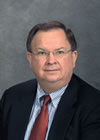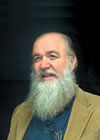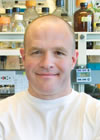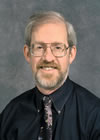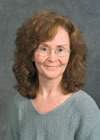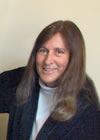
Accelerating
Toward a Dark Energy Mission
Summer Lecture Series
Starts with Director’s State of the Lab Address
Accelerating Toward a Dark Energy Mission
BY PAUL PREUSS
By late afternoon on Monday, May 17, Ray Orbach, director of the Department of Energy’s Office of Science, had spent a busy day at Berkeley Lab’s On-site Review, but he was still bubbling with energy. Accompanied by Lab Director Charles Shank, Orbach dropped by to cheer on 150 visiting scientists gathered at the Wide-Field Imaging conference to discuss the NASA/ DOE Joint Dark Energy Mission (JDEM).
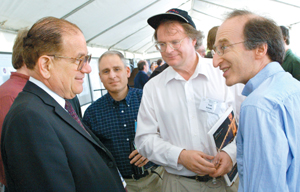 |
|
| Office of Science Director Ray Orbach (left) talks with JDEM competitors Tod Lauer (white shirt) and Saul Perlmutter (right) at the Wide-Field Imaging conference. Prior to this event, Orbach spent the day at Berkeley Lab’s annual On-site Review. |
“Come hell or high water, DOE will fund JDEM,” Orbach promised. He added, “NASA and DOE have very different philosophies, but we have agreed on a plan,” dedicating the first three years of the JDEM mission to dark energy, then opening to other kinds of observation.
“I’ll cut to the chase,” Orbach said. “You’re all wondering what’s going to happen with the Mars mission. In my opinion, it won’t interfere with JDEM.” He noted that although NASA has recently deemphasized cosmology, JDEM earned “the highest priority” in recommendations to the Office of Science and Technology Policy, indicating that “this launch is so important, and we are so far along, that it will carry the day.”
Orbach ended by praising those gathered for the “intellectual drive you have given the community” of astrophysicists, cosmologists, and high-energy physicists who have joined in enthusiasm for the dark energy mission.
Berkeley Lab was the conference’s logical host, JDEM having been inspired by the SuperNova/ Acceleration Probe (SNAP) conceived here. Beginning on Sunday, the conference maintained a packed schedule through Tuesday, exploring approaches to dark energy along with parallel uses for a satellite with a wide-field camera like SNAP’s.
At Sunday night’s kick-off banquet, Fermilab cosmologist Rocky Kolb humorously drew attention to the parallel paths of Saul Perlmutter and Martha Stewart. Kolb noted the curious role of coincidence in their careers: “Martha sells,” and the value of ImClone stock plummets; “Saul observes” (Type Ia supernovae, that is), and the value of the vacuum energy density has to be recalculated. This being the first hard evidence for the existence of dark energy, one wonders if Perlmutter had advance knowledge.
The biggest stir, aside from Orbach’s enthusiasm, came when Tod Lauer of the National Optical Astronomy Observatory introduced a competitor to SNAP — Destiny (Dark Energy Space Telescope). Both would fly 1.8-meter telescopes and gather spectra and light curves from thousands of distant supernovae but are otherwise strikingly different in philosophy and design.
SNAP has a spectrograph, huge CCD camera, and other detectors capable of imaging in both visible and near-infrared light. Destiny uses only infrared detectors and grisms (grooved prisms) yielding spectra. Versatile SNAP is capable of a wide range of observations, from gravitational lensing to faint comets. Destiny would study supernovae alone.
“Unlike DOE, NASA is big on competed projects,” Lauer said. “Destiny is a direct creature of this competitive process,” beginning when NASA and DOE joined forces, with NASA taking the lead. From the beginning the Destiny designers asked, “how simple can we make it?”
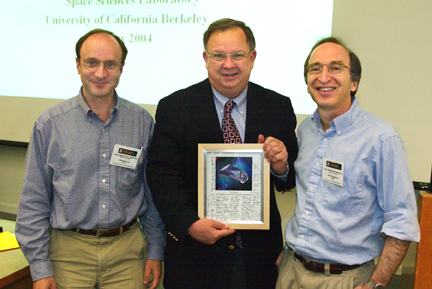 |
|
| Michael
Levi (left) and Saul Perlmutter (right) present Charles Shank
with a signed picture of the SNAP satellite. |
|
Led by Arizona State University astronomer Jon Morse, the Destiny group has strong ties to the Space Telescope Science Institute, which runs the Hubble Space Telescope. Among them, Robert Kirshner of the Harvard Smithsonian Center for Astrophysics, also at the Wide-Field Imaging conference, Adam Riess, and others were members of the High-Z Supernova Search Team that in 1998 vied with the Berkeley-Lab-based Supernova Cosmology Project to announce the accelerating expansion of the universe. Clearly their rivalry continues.
Summing up the proceedings, University of Melbourne astrophysicist Rachel Webster noted three approaches to studying dark energy and its complement, dark matter, emphasized by the participants: supernovae, galactic redshifts, and weak gravitational lensing.
SNAP, well-equipped and thoroughly thought-out, could pursue all three, plus numerous parallel lines of research. Said Webster, “We would like to see this level of detail on all proposals.” By contrast, Destiny offers simplicity and, presumably, economy, she said. The choice is fundamental and must be decided soon.
No sooner had the High-Field Imaging conference ended than its SNAP participants plunged into another head-scratching session, a two-day meeting of the SNAP collaboration itself. Buoyed by Orbach’s support and the enthusiasm of the Wide-Field crowd, Saul Perlmutter and Michael Levi called a break on Thursday to make a presentation to the man they credited with bringing SNAP to its present advanced state: Charles Shank.
“In 1999 Saul and I came up with this crazy idea to do something the Lab had never done before — build a spacecraft,” Levi recalled. “Shank wasn’t fazed. He said ‘follow the science,’ and his knowledge and political capital got us where we are today.” Levi and Perlmutter presented Shank with a framed drawing of the satellite, inscribed “in recognition of your tireless efforts” and signed by collaboration members.
“I’m touched and honored,” Shank said, adding “it’s easy to look good when you’ve got great people, and this project is easy to support — because the science is so exciting.”
For more about the Wide-Field Imaging conference, visit http://widefield.lbl.gov/.
Summer Lecture Series Starts with Director’s State of the Lab Address
BY RON KOLB
Berkeley Lab Director Charles Shank’s final State of the Laboratory
address before his retirement will kick off the 2004 Summer Lectures
program, a six-week series of informational talks featuring some of
the Laboratory’s most dynamic scientists.
Shank’s assessment of the Laboratory — in his 15th and
final year as director — will take place at noon on Thursday,
June 10 in the Building 50 auditorium. The subsequent five lectures
will take place on successive Wednesdays at noon.
The diverse series of offerings this year includes nontechnical talks in the fields of computing, engineering, the life sciences, and the environment. A tradition since it was first conceived as a student-focused activity by the Center for Science and Engineering Education in 1983, the Summer Lecture Series has been run by the Lab’s Communications Department for the last 10 years.
The talks are structured to showcase the broad range of research that represents Berkeley Lab. Lab employees as well as visiting summer students and teachers are encouraged to attend and to learn more about the exciting science that takes place on the Hill.
The 2004 program includes:
Director Charles Shank, Bill Johnston, Jay Keasling, Jim McMahon, Carolyn Larabell, and Deb Hopkins. June 16: Bill Johnston, Computing Sciences: Johnston, a distinguished networking and computing researcher, is the manager of the Energy Sciences Network (ESnet), a leading-edge, high-bandwidth network funded by DOE’s Office of Science. Used for everything from videoconferencing to climate modeling, and flexible enough to accommodate a wide variety of data-intensive applications and services, ESNet’s traffic volume is doubling every year and currently surpasses 200 terabytes per month.
Johnston is also a key member of a group of people who have pioneered Grid computing over the last five years. Grids are specialized configurations of computing systems, storage systems, networks, and experimental facilities for advancing scientific collaborations between geographically dispersed institutions.
June 23: Jay Keasling, Physical Biosciences: Keasling is the first head of the newly formed Synthetic Biology Department, first of its kind in the country. The department will integrate a wealth of new data and experimental advances in biology, engineering and nanoscience to develop organisms and biologically-inspired systems that will one day convert plentiful, renewable resources into energy, replace environmentally unfriendly chemical syntheses, seek out and destroy pathogens, and remediate recalcitrant environmental contaminants.
Last year, he led a team that engineered a way to produce a next-generation malaria drug within E. coli. Keasling combined yeast and wormwood genes within E. coli, then optimized the chemical pathway by 10,000 times to produce amorphadiene, the chemical precursor to the antimalarial drug artemisinin.
June 30: Deb Hopkins, Engineering: Hopkins is head of the Industrial and Energy Partnerships program in Engineering, which works with industries like automobile, mining and paper to improve their evaluation and measuring techniques.
For several years, she has coordinated a program at Berkeley Lab funded under the Partnership for a New Generation of Vehicles, a collaboration between the federal government and the U.S. Council for Automotive Research. Nondestructive evaluation techniques to test a car’s structural integrity are being developed for auto assembly lines.
July 7: Carolyn Larabell, Physical Biosciences: Larabell, a cell biologist and microscopist, gave a cell imaging talk in 1999 that was among the most popular of the Summer Lecture Series. Her main targets are the proteins inside living cells and the things they do. To image these proteins and their activities, Larabell has mastered both electron and confocal microscopy and is blazing new trails with the x-ray microscope, XM-1, at Berkeley Lab’s Advanced Light Source (ALS).
In April it was announced that, utilizing National Institutes of Health and DOE grants totaling $1.3 million, she and her colleagues will build a new, first-of-its-kind ALS transmission x-ray microscope (TXM) off a bend magnet beamline at the ALS. The instrument holds the promise of CAT scans for biological cells, and other unprecedented capabilities for cell and molecular biology studies, plus a better understanding of human diseases at the molecular level and possibly new discoveries for treating them.
July 14: Jim McMahon, Environmental Energy Technologies: McMahon is head of the Energy Analysis Department in EETD, which provides technical analysis to the Department of Energy on things like energy efficiency appliance standards. McMahon and his colleagues helped the nation save tens of billions of dollars in energy costs since the standards program began.
Now his Water-Energy Technology Team (WETT) is applying its expertise to the linked problem of energy and water. Each of us requires more than 500 gallons per person per day for food production, plus an additional 465 gallons to produce household electricity. WETT hopes to mine some of the numerous opportunities to save energy and water by applying new technologies.
Dynamic Duo Is the ‘Voice’ of Berkeley Lab
BY D. LYN HUNTER
Tucked in a cozy office in Building 50E are two women, both wearing head sets, speaking in measured tones, and gently clicking away on their computer keyboards.
With the soft jazz quietly emanating from a radio in the corner, Marilyn Wong and Rosa Cruz, Berkeley Lab’s telephone operators, calmly dispatch a never-ending stream of calls coming in from both on and off the Hill.
“It’s pretty much constant, from 7:30 a.m. to 5 p.m. everyday,” says Cruz, who’s been an operator since 1997. “And the calls come from all over the world. With the language differences, it’s not always easy to figure out what they need.”
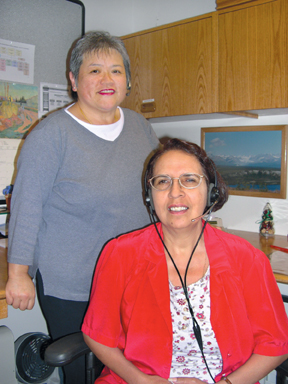 |
|
| Lab operators Marilyn Wong and Rosa Cruz. | |
Fortunately, Cruz is fluent in Spanish and can decipher requests from callers speaking Italian and Portuguese, while Wong, an operator for three years, speaks Cantonese.
“Language barriers aren’t the only issue,” says Wong. “Just as challenging are the callers who don’t know exactly who or what they are looking for, so we have to ask questions to figure out where to direct their calls.”
While lesser souls would buckle under this kind of constant pressure, Cruz and Wong deal with these and other hurdles with unflagging aplomb.
Part of what makes them so adept is their vast experience working at the Lab. Wong has racked up 26 years so far (she spent 23 years at the Photo Lab), while Cruz has 35 years under her belt (with previous stints in Human Resources and the Telephone Services Center). This institutional memory — coupled with knowing hundreds of people at the Lab — aids in their ability to connect callers with the right sources.
In addition to their operating duties for the Telephone Services Center, the two also provide pagers, set up conference calls, update the online directory, and supply phone books.
Despite their close proximity to each other — they sit virtually back-to-back eight hours a day, five days a week — the two get along swimmingly.
“I’m an introvert and Marilyn’s an extrovert. I like the office warm and she likes it cool,” says Cruz of their differences. “But we somehow balance each other out.”
“If things aren’t going well for me, Rosa steps it up, and I do the same for her if she’s having a bad day,” adds Wong. “Plus, we both like jazz music.”
And on this point they also agree: after a long, hard day at the switchboard, the last thing Wong and Cruz want to do when they get home from work is talk on the phone!
Mildred Dresselhaus Presents Plan for a Hydrogen Economy
BY DAN KROTZ
A hydrogen economy may be difficult to implement, but it’s not impossible, according to Mildred Dresselhaus, former head of DOE’s Office of Science under President Clinton, who spoke before a packed Building 50 auditorium on May 19. The Massachusetts Institute of Technology professor’s talk spelled out what’s needed from the nation’s scientific community to see a day — most likely decades away — when people fill their cars with hydrogen instead of fossil fuel.
“Hydrogen is potentially an abundant, clean, secure and flexible energy carrier,” she said. “However, it is not yet competitive with the fossil fuel economy in terms of cost, performance, and reliability.”
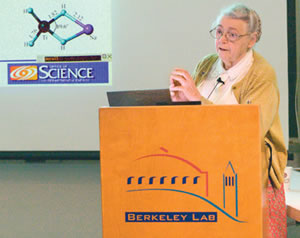 |
|
| Mildred Dresselhaus, head of DOE’s Office of Science under President Bill Clinton, spoke at Berkeley Lab on May 19. |
Dresselhaus added that a safe, efficient, and economical means for hydrogen production, storage, distribution, and use must be developed. “In all of these sectors, present knowledge and technology are far short of DOE requirements,” she said. That could change. Last year, President Bush announced a $1.2 billion Hydrogen Fuel Initiative to develop the technology needed for commercially viable hydrogen-powered fuel cells.
So what’s needed to get from today’s fossil-fuel economy to tomorrow’s hydrogen economy? Dresselhaus listed several technological goals. The first is low-cost and efficient solar energy production of hydrogen. There’s also nanoscale catalyst design, and the development of materials that process hydrogen based on biological processes.
“We are very interested in the bio option,” says Dresselhaus. “Nature can produce hydrogen at room temperature very efficiently, and we need to study this option.”
Other goals include durable cathodes for low temperature fuel cells, membranes and separator processes for hydrogen production and fuel cells, and novel hydrogen storage materials. Dresselhaus emphasized that these developments will require a strong and highly interdisciplinary research and development effort.
“The hydrogen economy is really hard to do, but it’s not impossible. When I talk to young people, I see careers for them,” she said.
In addition to heading the Office of Science under President Clinton, Dresselhaus received the National Medal of Science, and is the past president of both the American Physical Society and the American Association for the Advancement of Science.
Health Care Facilitator Program Helps You Navigate the System
BY MONICA FRIEDLANDER
 |
|
| Loida Bartolome-Mingao brings both her personal and professional experience to bear on her job as Berkeley Lab’s first health care facilitator. |
Loida Bartolome-Mingao’s office could be seen as the Intensive Care Unit of the Benefits Department’s response team. Every month — every slow month, that is — the phone on her desk rings 140 times with health and welfare cases involving matters that fall outside the routine of coverage and eligibility inquiries handled by Benefits reps — everything from simple denied health insurance claims to highly escalated coverage issues. But every time Bartolome-Mingao picks up the phone, she doesn’t think of it as another claims case, but as a person in a bind who needs her help.
“I feel for the position,” she says. “It’s not just a billing issue to me, not a benefits coverage issue. It’s a matter of compassion.”
Berkeley Lab’s first health care facilitator (HCF) since 2002, Bartolome-Mingao brings a wealth of experience, both personal and professional, to a position that requires her to wear more hats than a traveling cap salesman. Depending on the case, she can act as a counselor, mediator, investigator, a lightning rod for angry callers, and perhaps just as important, a source of moral support for those who would otherwise be left to navigate through the difficult maze of the health care system by themselves.
Despite the enormous demands on her time and patience, it is not surprising that Bartolome-Mingao draws so much satisfaction from her job, considering that it was her own health crises that indirectly led her to this position.
A recent cancer and stroke survivor, she experienced first-hand a patient’s worst fears and frustrations, as well as the system’s bureaucratic tangles. If she can in turn lessen someone else’s pain even a little, then she feels she has done her job.
“I can relate to the urgency on the part of both patients and their families who need to get their problems solved — now! That’s where my passion and drive come from,” she says.
The Program
Funded through the UC Office of the President, the HCF program started in 1999 as a pilot project on the campuses of UC Berkeley and UC Irvine. It proved to be so successful that two years later the program was approved for expansion to all University of California campuses and the three UC laboratories. By 2003, an HCF was in place at each location. At Berkeley Lab the program started in 2002.
The program’s purpose is to make sure health plan members — eligible employees, retirees and their dependents — understand and can take full advantage of the benefits and services available to them through their elected UC-sponsored plans.
When a problem arises that cannot be resolved by taking routine steps, the HCF has two choices: he or she can either advise members about their options or, in some cases, further investigate the situation and actually intervene on their behalf. To be able to intervene, however, the HCF needs to get a member’s permission as well as certain personal confidential information, as required by current privacy regulations.
Here at Berkeley Lab, Bartolome-Mingao does all of the above on the health and welfare side. The Benefits Department’s additional staff provide assistance and act as filters, sending the more difficult cases to the HCF.
“I’m like a private investigator,” she laughs.
Issues that pile up on her desk involve billing discrepancies, health claims, cases of patients not obtaining referrals to specialists, or provider disruption situations.
“When members come to me, their level of frustration is at a max. They usually do try to resolve the problems themselves, but have not gotten the resolution they need,” she says.
Some people call with a quick issue she can solve with a simple phone call, such as an incorrect code entered on a form. Other cases can drag on for months or more, and some involve heart-wrenching, emotionally-charged situations.
“Sometimes people call me from the hospital or nursing home, not knowing if the nursing care they need will be covered,” Bartolome-Mingao says. “I need to get on it right away. I place myself in their shoes. ‘What can I do? How can I make it easier for them?’”
One of the most rewarding cases she dealt with involved a retiree who after a long hospitalization found himself with the bill for part of his stay in the hospital denied by the insurance carrier. She advised him to appeal the case, and the claim was denied again. Finally she helped him take the case to the highest level, the state’s Department of Managed Health Care.
“It took almost a year, but the case was reviewed several times and the plan carrier’s decision was ultimately overturned. This was one of the most joyous moments for me,” she said.
The Role of the HCF
Bartolome-Mingao makes it very clear that for all her compassion and advice, she does not act as an advocate or representative for the member.
“This is not one-sided,” she explains. “Sometimes I have to say no to members. Coverage may be rightfully denied under their plan. I’m caught in the middle all the time.
“Often I’m told about the situation at hand but not about the full background. In the process of investigating the case I find out a lot more. What’s interesting is when I piece it together and figure out ‘Aha! This is what really happened!’”
A New Lease on Life
Bartolome-Mingao has not always had the skills to conduct such complex human resource detective work. A veteran of UC San Francisco, where she spent her entire professional career until she came to Berkeley Lab in 2000, her background was in administrative management, particularly in the human resources area. But it was really over the last four years, when her own life took some unexpected turns, that she took her career to a higher level.
In early 2000, Bartolome-Mingao, a wife and mother of two teenagers, was diagnosed with and treated for ovarian cancer. A short two years later, she had a stroke right here at the Lab, after having finished a new employee orientation in Building 937, where she works. She survived the ordeal and made a full recovery, but these experiences changed her life in profound ways.
“I underwent a dramatic transition over the last four years,” she says. “I felt the need to fulfill my life, to be the best I can be at everything I do, whether it’s for my family, my church or my work. This job is part of it, so I decided to continue to pursue my education in an HR management program, while maintaining a healthy balance in doing everything else.”
That program and the extensive training for the job of HCF prepared her for the tough demands of the position. But that was just the beginning.
“I have to keep educating myself, because I have to know the system and constantly keep up with changes so I can pass the information on to the members.”
Moreover, Bartolome-Mingao can never truly leave her work behind. “This job involves people, and time is of the essence. If I’m sick, I still take the job home with me. It’s hard to separate yourself from people. I set my boundaries — you have to — but it’s not easy.”
The other tough part of her job is that hard as she may try, she cannot make everyone happy.
“It’s not always a pretty picture,” she says. “Sometimes people are angry and expect me to work miracles for them. I can’t. I do the best I can, but if someone is not covered under the system, there’s nothing I can do for them. I know that in this position you can’t please everyone.”
But she doesn’t have to. It’s those cases where her call or intervention made a difference in someone’s life that make her job so fulfilling.
“Just the simplest ‘thank you’ or ‘everything worked out’ means a lot,” she says. “Little things mean the most to me. That’s because they may be little to me, but to the people involved they’re very big. That’s extremely gratifying.”
The Program at a Glance
Whom do I contact?
Loida Bartolome-Mingao, 510-486-6997
hcf@lbl.gov or lcbartolome-mingao@lbl.gov
Who is eligible?
All active and retired UC-sponsored health plan members and their
eligible dependents
What can the HCF do for me?
• Help you understand your plan coverage and rights
• Assist with billing issues/health claims
• Assist in resolving issues with your doctor, medical group
or
plan carrier
What can the HCF not do?
• Retirement counseling
• Legal mediations, appeals & grievances
• Eligibility and verification of coverage and services
Who funds and runs the program?
Funded by the UC Office of the President, the program is run
by Berkeley Lab’s Benefits Department (under Human Resources).
DNA Repair Secrets could lead to better therapies to Fight Cancer
BY DAN KROTZ
Berkeley Lab scientists have unlocked a secret of DNA repair that could ultimately make cancer cells more sensitive to radiation therapy, a discovery that may translate to safer and more efficient cancer treatment. It could also help expedite the development of cancer-fighting drugs.
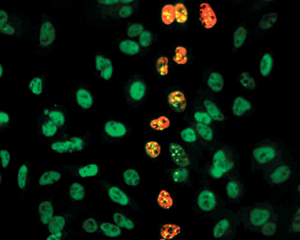 |
|
| DNA double-strand repair caught in the act: localization of active DNA-dependent protein kinase threonine 2609 (red) at damaged sites after laser micro-irradiation. | |
Their research focuses on an enzyme that plays a key role in repairing DNA double-strand breaks. The enzyme, called a DNA-dependent protein kinase, targets broken DNA strands and helps mend the strands back together through a process called end-joining. In healthy people, this process is critical to cell survival. Unfortunately, the enzyme also repairs double-strand breaks suffered by the DNA of cancerous cells, meaning it counteracts the effects of ionizing radiation that is commonly used to kill tumors.
What’s needed is a way to stop the enzyme from doing its job in cancerous cells, and this requires a better understanding of how it works. On this track, David Chen, Ping-Chi Benjamin Chen, and Doug Chan of the Life Sciences Division recently identified two sites on the DNA-dependent protein kinase that are modified with phosphate in response to radiation. This modification activates the DNA-dependent protein kinase and enables it to repair DNA strands. They also found that a mammalian cell line that expresses a mutation at the two sites, threonine 2609 and serine 2056, was unable to optimally repair its DNA. Because of this, the cells showed an increased sensitivity to radiation.
Based on this research, the team believes that if a drug could be developed that renders the two sites inert, then doctors could prevent DNA double-strand repair in patients undergoing radiation treatment.
“A cell lacking this kinase will become extremely radiation sensitive,” says David Chen. “We could reduce a patient’s radiation dose and reduce their side effects. It would make radiation therapy much more efficient.”
Chen’s team hopes to soon begin high-throughput screening for molecular inhibitors of the DNA-dependent protein kinase, followed by preclinical studies of promising candidates.
“The ultimate goal is to create a situation in which a patient undergoing cancer therapy receives less radiation,” says David Chen. “In addition, the molecular inhibitor would only target cancerous cells, so healthy cells could repair their DNA but cancerous cells could not.”
In addition to laying the groundwork for therapies that make cancer
cells more sensitive to radiation, their research could lead to a
better way to monitor the effectiveness of some cancer treatments.
David Chen and his research team have generated antibodies that recognize
the sites threonine 2609 and serine 2056 after they are modified.
These antibodies can be used to identify areas in the cell where activated
DNA-dependent protein kinase is helping to repair double-strand breaks.
This could enable scientists to evaluate treatments that target DNA
repair of cancer cells — a feat that was impossible before Chen’s
team identified the two sites.
Engineering Division Looks to the Future
BY PAUL PREUSS
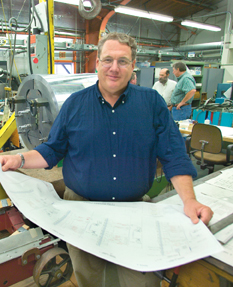 |
|
| Kem Robinson, acting director of the Engineering Division, has overseen the transition to a forward-looking engineering capability at Berkeley Lab. |
At an all-hands meeting of Berkeley Lab’s Engineering Division held on Friday, May 14, Deputy Director for Operations Sally Benson praised the division as a “vector of innovation,” unique among the Department of Energy’s national laboratories for its matrix organization.
The division’s acting director, Kem Robinson, noted that “DOE has acknowledged engineering problems across the board” and that the Office of Science is “examining our way of doing it … We are well placed to influence” the way DOE meets the challenge of maintaining engineering skills for cutting-edge science.
Reporting on the recently completed reduction in force, which affected 61 people through voluntary resignations and involuntary lay-offs, Benson said, “We regretted this action and would have done something else if we could, but we were overcome by costs … Engineering is now solvent. It’s time to look at what will happen and what will be needed.”
Robinson detailed the kinds of projects Engineering could be dealing
with soon and how best to prepare for them. Berkeley Lab is already
involved in several high-profile projects and has good prospects of
participation with other laboratories in several more.
These include ongoing support for SNAP (the SuperNova/Acceleration
Probe), inspiration and chief competitior for NASA and DOE’s
high-priority Joint Dark Energy Mission. The Linac Coherent Light
Source, LCLS, is well under way at the Stanford Linear Accelerator
Center and, said Robinson, “will probably need our help”
through “a big increase in people in ‘05.”
The Lab will play a role in developing the pre-accelerator and detectors for RIA, DOE’s high-priority Rare Isotope Accelerator, and will also assist in the design of the neutral beam injection system and superconducting magnets of ITER, the international thermonuclear fusion project, once its site has been selected.
For NUSL, the National Underground Science Laboratory, the National Science Foundation is considering half a dozen sites. Berkeley Lab is associated with what Robinson calls “two of the more viable sites. NSF realizes it needs engineering expertise it can only get from DOE national labs.”
In biotechnology, the multi-institutional BRIDGE initiative (Biomolecule Resource to Initiate Discovery and Guide product Engineering) will need engineering expertise in instrumentation and process engineering.
Robinson outlined a schedule for technical and strategic planning to meet all these challenges.
Appreciation for his handling of the division’s difficult transition was reflected in audience questions about his status — he indicated that Benson has established a search committee to name a permanent division director — and even more strongly in the audience’s heartfelt applause when he brought the all-hands meeting to a close.
Emergency Chief Leaves Lab Secure
BY LYNN YARRIS
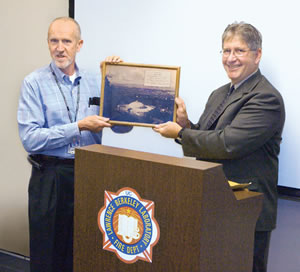 |
|
| EH&S Acting Director Robin Wendt (right) presents Don Bell with a plaque for his 12 years of service. | |
“Providing the Laboratory and its employees with a secure environment while maintaining as much as possible our traditional openness was probably the greatest challenge, and I think we succeeded,” says Don Bell, Berkeley Lab’s Emergency and Security manager, who is retiring on May 28 after more than 12 years of service here.
“Since the events of September 11, 2001, the emphasis of my job has been on security,” he says. “Obviously, we’re not as open as we used to be, but we’ve made a real effort to protect the Laboratory’s assets without being too restrictive on visitors and scientific guests.”
Bell came to the Laboratory at the start of 1992, after 20 years with the U.S. Army, the last of which were spent stationed at the now-closed Presidio base. Arriving on the heels of the “Tiger Team” safety inspections ordered by then Secretary of Energy Admiral James Watkins, Bell was an integral part of a culture change at the Lab with respect to occupational safety issues.
“Under the leadership of David McGraw (then head of EH&S), the Lab moved to an integrated safety management program,” Bell says. “Instead of a compliance approach based on checklists, safety was incorporated into daily operational practices. As a result, there has been a significant decrease in the number of reportable on-the-job accidents.”
Bell’s first visit to the Laboratory came within days of the 1991 Oakland hills fire. The air was still thick with smoke and the smell of the scorched acreage, as he made his way up narrow, curvy roads, bordered by the fire sticks that are eucalyptus trees. He remembers thinking, “Do I really want to be in charge of handling emergencies here?”
In his role as manager of the Lab’s plans for dealing with emergency
situations, Bell recognized that Berkeley Lab is part of a larger
community. He oversaw a concentrated effort to reach out and cooperate
with our neighbor organizations and institutions.
“We now coordinate emergency preparedness activities with federal,
state and local government agencies, and with the UC Berkeley campus,
Alta Bates Hospital, the Bayer Corporation and others,” he says.
“The Laboratory is no longer isolated in what we do to prepare
for a possible crisis.”
Bell also oversaw the move to contract out for police and fire protection services, a move he says resulted in substantial money savings while expanding and improving the quality of those services.
“We are a scientific research laboratory and science is what we do best,” Bell says. “Our philosophy has been let’s do what we’re good at and, when appropriate, hire others to do what they’re good at.”
For the future, Bell plans to ski, golf, hike, and have fun. He and his wife Joyce will spend most of their time at their house in Mammoth Lakes in the Sierras. Looking back at his time here at Berkeley Lab, Bell says: “I’ve seen a lot of progress, but nothing happens without management support. I was fortunate to have the support of people like Chuck Shank, Klaus Berkner, Sally Benson, and David McGraw.”
New Facility Managers See Great Opportunities for Improvements
BY RON KOLB
 |
 |
|
| Steve Black (L); Jerry O'Hearn | ||
The one common thread that ties George Reyes, Steve Black and Jerry OHearn together is the UC Davis campus, where all have served. But don’t get the idea that Berkeley Lab will start looking like Davis now that three of its former top facilities managers are here.
Fact is, the geography and landscape couldn’t be more different. And a place like Berkeley Lab, whose mission is pure research, has a whole different set of facilities requirements than a campus at which teaching students is the core. OHearn, the new department head for Design and Construction, probably speaks for all three when he says, “It’s a new challenge, and in a positive way. It’s one that I live for.”
Reyes, the ex-deputy for facilities at Davis who arrived at Berkeley Lab last year by way of UC Irvine, has been busy reorganizing the Facilities Division at Berkeley Lab. He recently announced the acquisition of OHearn, after 18 years as Davis’ associate director for design and engineering, and Black, as department head for Plant Operations. Black moved from his position as manager for building operations for Santa Clara County, which followed his four years at Davis.
Both men are engineers by training with extensive resumes in management in both public and private sectors. Black “brings to his new role a wealth of abilities and skills, including intimate knowledge of the Maximo information system, various facilities service delivery models, and a solid background in developing facilities procedures and policies that enhance cost effectiveness, productivity, and work flow,” Reyes said. He also cited OHearn’s successful effort at Davis “to design, develop and implement a new financial, project management and document management information system,” which has become a model for managing major construction projects in the UC system.
Black said his first priority will be to develop an optimal organizational structure and service model that fit the character of Berkeley Lab, an assessment that might take him six months. So far, he’s impressed by what he’s seen.
“We have really good tools here already in place,” he said. “So we’ll be building on the good things.” Projects need to be pulled together and planned as a whole, he added, pointing to the Lab’s forthcoming Long Range Development Plan (LRDP) as an innovative blueprint that “addresses issues like pedestrian and car circulation, utility corridors, and service entrances in ways that I have not seen in campuses’ long-term plans.”
OHearn, who says he has the “heart of an architect,” is impressed by the Lab’s prominent buildings, landscaping, and “world-class” topography and views. “Some things we can do better,” he said, “like the plethora of trailers here. It makes sense to put people into permanent facilities and improve their workspace, and we should foster that when opportunities allow.”
Both said they would be working closely together in a synergy of design, construction and maintenance, collaborations that were not uncommon when they shared their visions with Reyes at UC Davis.
Berkeley Lab View
Published every two weeks by the Communications Department for the employees and retirees of Berkeley Lab.
Reid Edwards, Public Affairs Department head
Ron Kolb, Communications Department head
EDITOR
Monica Friedlander, 495-2248,
msfriedlander@lbl.gov
Associate EDITOR
Lyn Hunter, 486-4698 lhunter@lbl.gov
STAFF WRITERS
Dan Krotz, 486-4019
Paul Preuss, 486-6249
Lynn Yarris, 486-5375
CONTRIBUTING WRITERS
Jon Bashor, 486-5849
Allan Chen, 486-4210 David Gilbert, 925-296-5643
FLEA MARKET
486-5771, fleamarket@lbl.gov
Design & Illustration
Caitlin Youngquist, 486-4020
TEID Creative Services
Communications Department
MS 65, One Cyclotron Road, Berkeley CA 94720
(510) 486-5771
Fax: (510) 486-6641
Berkeley Lab is managed by the University of California for the U.S. Department of Energy.
Online Version
The full text and photographs of each edition of The View, as well as the Currents archive going back to 1994, are published online on the Berkeley Lab website under “Publications” in the A-Z Index. The site allows users to do searches of past articles.
Flea Market
- AUTOS & SUPPLIES
‘01 VOLVO C70 COUPE, 25K mi, still under warrantee, $20K, Barbara, 393-1045
‘00 VW BEETLE, $9,800, 50K mi, 5 speed, 30 mpg, loaded, exc cond, Bob, X4451, 548-2429
‘99 GMC SUBURBAN SLT, 45K mi, new tires, brakes & battery, leather, front & rear air, ABS, pwr win/locks/steer, cruise, orig owner, exc cond, Steve, X7156, (925) 673-1234
HOUSING
ALBANY, 1 bdrm condo, GateView Apts, 555 Pierce Street, unfurn, yery clean, new carpet, exc cond, all util paid, 1-car parking in sec garage, wheelchair access, view, pool, tennis, gym, 24 hr sec, refrig, stove, dw, 12-mo lease, $1,100/mo + $1,500 dep, Mary, X4701, 816-9702
ALBANY, 2/2 condo, fully furn, spacious 1,234 sq ft, sunny, quiet & eleg, sleeps 4, laundry rm, view, swim pool, exercise rm, rec rm, 2-car garage, close to market/El Cerrito Plaza/BART/pub trans, Geoffry, 848-1830, gfchew@mindspring.com
BERKELEY, delightful cottage, fully furn, $650/mo, extra lge rm, 1 pers only, fully furn, breakfast each day for cottage & room, walk to LBNL shuttle, util extra, $750/mo, Helen, 527-3252
BERKELEY, Carleton/Grant, nr BART/ shops/Lab shuttle, close to LBNL, newly renov 2 bdrm apt, grnd flr of 2-story Victorian house, sunny southern exposure, front garden, w&d, custom tile flrs, no smok/pets, $1,400/mo, incl part utils, avail immed, Richard or Hope, 845-1723
BERKELEY, sabbatical family house, 3 bdrm 2 bth, hot tub, furn, Ordway St. off Gil-man, 2 bl to prim chool & shops, nr campus/bus/BART, no cats, $2,000 incl water, garbage, elec but not gas, 1st+last+dep $3,000, avail 8/1-8/15/2005, min 10-mo lease, David or Leslie, 526-8476 (h), 642-1140 (o), Leonard@socrates. berkeley.edu
BERKELEY HILLS, fully furn rm w/ sep entry, full kitchen privil, w/d, quiet neighbrhd, lovely backyard, next to bus stop, avail now, $850/mo incl util, labartists@ aol.com, Arun, 524-3851
KENSINGTON, fully furn 3 bdrm home, view, quiet setting, 1 cat, avail for vis scientist during summer or fall terms, $1,600/mo + sec dep, Ruth, 526-2007, 526-6730
NORTH BERKELEY, by wk/mo, fully furn 1/1 flat, quiet, spacious, dish TV, laundry rm, priv garden, gated carport, walk to Lab shuttle/UCB/BART/downtown, Geoffry, 848-1830, gfchew@mindspring.com
NORTH BERKELEY, huge 1 bdrm house, fully furn, w/d, DSL wireless connection, no pets/smok, $1,000/mo+dep+util or $400/wk, avail 6/7-7/20, shared rear & fr garden, 5 min walk to N. Berkeley BART, <2 miles from campus, Gilad, 219-4876, X5589
PIEDMONT, 3 bdrm/2bth, spacious, peaceful, updated condo, nr Piedmont Ave, view from balcony, remodeled kitchen, appliances/granite, custom tile & bth, Italian marble, pedestal sink, tub, nr LBL/MacArthur BART/pub trans, 1-yr lease, $2,350/mo, util incl, Corie, 495-2594, cyralston@lbl.gov
PITTSBURG, room avail in new house in a quiet neighborhd, close to Bay Point/Pittsburg BART, grocery, shops, library, $600/mo incl water & gas, no smok/pets, pref student or professional, Charles, (925) 708-6977
HOUSING WANTED
ROOM wanted for visiting Dutch scientist betw 6/10 and 7/31, pref close to Lab, Simon, X6094, SJGeorge@lbl.gov
MISC ITEMS FOR SALE
BIKE, pink, girl’s, good for ages 4 to 6, in good cond, $10, Francesca, X7193
PILATES DVD, beginning mat workout, new/unopened, $8.50, Sherry, X6972
YOSEMITE, 2 campsites for sale, 7/21 to 7/25, campsites #180 & #185, $144 for both, Yosemite campsites are sold out for the summer, Michael, X4780, (925) 930-0672
FREE
STAIR STEPPER exercise machine, ProForm 3001 STX, programmable motivational stepper, good cond, Will, 562-7242, X5689
VACATION & OUT OF TOWN
ALEXANDRIA, Virginia, Old Town Alexandria, fully furn 1 bdrm condo, 7th of 8 flrs, balcony, lots of light, full new carpeting, w/d, ac, dw, pool & exercise rm, undergr parking, 1-min walk to metro, 20 minute to Mall, no smok/pets, avail 6/1-9/1, $1,200/ mo, electricity not incl, Doug, 486-6095, Joanna, 339-6915
NORTH LAKE TAHOE, house at Kings Beach, 3 bdrm/2bth, sleeps 6, full kitchen, liv rm & din area w/ fp, quiet cul-de-sac, great neighborhd, 1 mile to public beach, $150/night, 2 nights min + $75 cleaning fee or $725/week, Vlad or Linda, 849-1579
SOUTH LAKE TAHOE, spacious chalet in Tyrol area, close to Heavenly, fully furn, sleeps 8, sunny deck, pool & spa in club house, close to casinos, attractions, $150/day + $75 cleaning fee, Angela, X7712, Pat or Maria, 724-9450
Flea Market Policy
Ads are accepted only from Berkeley Lab employees, retirees, and onsite DOE personnel. Only items of your own personal property may be offered for sale.
Submissions must include name, affiliation, extension, and home phone. Ads must be submitted in writing
(e-mail: fleamarket@lbl.gov, fax: X6641), or mailed/delivered to Bldg. 65.
Ads run one issue only unless resubmitted, and are repeated only as space permits. Ads must be submitted in writing and be no more than 50 words in length. The submission deadline for the April 30 issue is Friday, April 23.
Awards & Honors
Graham Fleming Wins Porter Medal
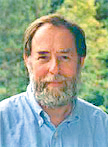 |
|
| Graham Fleming |
Graham Fleming, director of the Lab’s Physical Biosciences Division, was selected by the photochemical societies of Europe, Asia and the Americas to receive the Porter Medal. The honor recognizes Fleming’s lifelong work in the field of photochemistry. The medal is presented every two years on the occasion of the International Union of Pure and Applied Chemistry (IUPAC) symposium. Fleming will accept the medal in July during the ceremony in Spain.
Federal Laboratory Consortium Honors EETD Researchers
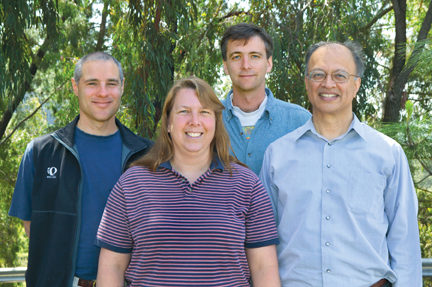 |
|
| David Lorenzetti, Tracy Thatcher, Phil Price, and Ashok Gadgil | |
The work of a team of Environmental Energy Technology researchers on “Minimizing Casualties from a Chem/Bio Attack” has received a 2004 Federal Laboratory Consortium Award for Excellence in Technology Transfer. The team includes Phil Price, Ashok Gadgil, Tracy Thatcher, Michael Sohn, David Lorenzetti, Rengie Chan, Emily Wood, Woody Delp, Sondra Jarvis, Richard Sextro, Elizabeth Finlayson, Buvana Jayaraman, Sheng-chieh Chang, and Seungbae Hong. The award recognizes outstanding work leading to the transfer of federally-developed technology to the marketplace.
Alivisatos Named AAAS Fellow
 |
|
| Paul Alivisatos |
Materials Sciences Division’s Paul Alivisatos, a leading authority in nano-science research, was among 178 new fellows elected to the American Academy of Arts and Sciences (AAAS). Foun-ded in 1780, the AAAS includes more than 150 Nobel laureates and 50 Pulitzer Prize winners. Last month Alivisatos was also elected to the National Academy of Sciences (see the View, April 30).
Dernburg Receives Early Career Scientist Award
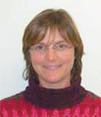 |
|
| Abby Dernburg | |
Abby Dernburg of the Life Sciences Division received a “Presidential Early Career Award for Scientists and Engineers” from the White House. The honor is the nation’s highest for professionals at the outset of their independent research careers. Fifty-seven researchers were honored in a recent ceremony.
Canadian University Honors Evans
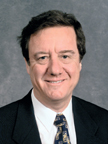 |
|
| James W. Evans |
James W. Evans, a principal investigator in EETD’s Building Technologies Department, is the recipient of the 2004 Brimacombe Prize given by the University of British Columbia. The prize honors “a single or sustained contribution to materials process engineering deemed outstanding.” Evans is also a professor of metallurgy on campus.
Heeger Wins Postdoc Lecture Prize
 |
|
| Karsten Heeger | |
Karsten Heeger of the Physics Division was the recent recipient of Case Western Reserve University’s Michelson Postdoctoral Prize Lectureship, awarded annually to a junior scholar active in a field of physics. The lectureship has become established as one of the premier awards for young Ph.D.s in physics in the country.
Jacobsen Lauded for Excellent Teaching
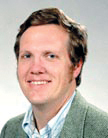 |
|
| Robert Jacobsen |
Lab researcher and associate professor of physics Robert Jacobsen was among five UC Berkeley faculty members presented with a 2004 Distinguished Teaching Award. The award, bestowed by Berkeley’s Academic Senate, is the highest honor for instruction given by the campus.
Prausnitz Receives Italian Honorary Degree
 |
|
| John Prausnitz | |
John Prausnitz, a scientist in the Chemical Sciences Division, recently received an honorary Doctor of Engineering degree from the University of Padua in Italy. The degree was conferred in a ceremony in an ancient palazzo where Galileo lectured 400 years ago.
Romano Receives Alvarez Fellowship
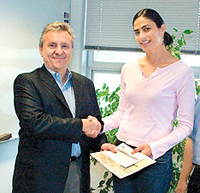 |
|
| Horst Simon (L); Raquel Romano |
Raquel Romano of the Computational Research Division has been selected as the next Luis W. Alvarez Post-Doctoral Fellow in Computational Science. She is working to develop computer vision and image processing tools to help biologists better understand why some cells become cancerous.
Zeman is Lab’s Newest Health Physics Fellow
 |
|
| Gary Zeman | |
Gary Zeman, head of Berkeley Lab’s Radiation Safety program,
was selected to be a Fellow of the Health Physics Society (HPS). He
was honored for his contributions in the field of dosimetry, his study
of the health effects of electromagnetic radiation, for the development
of a health physicist certification review course, and for his years
of service to HPS.
